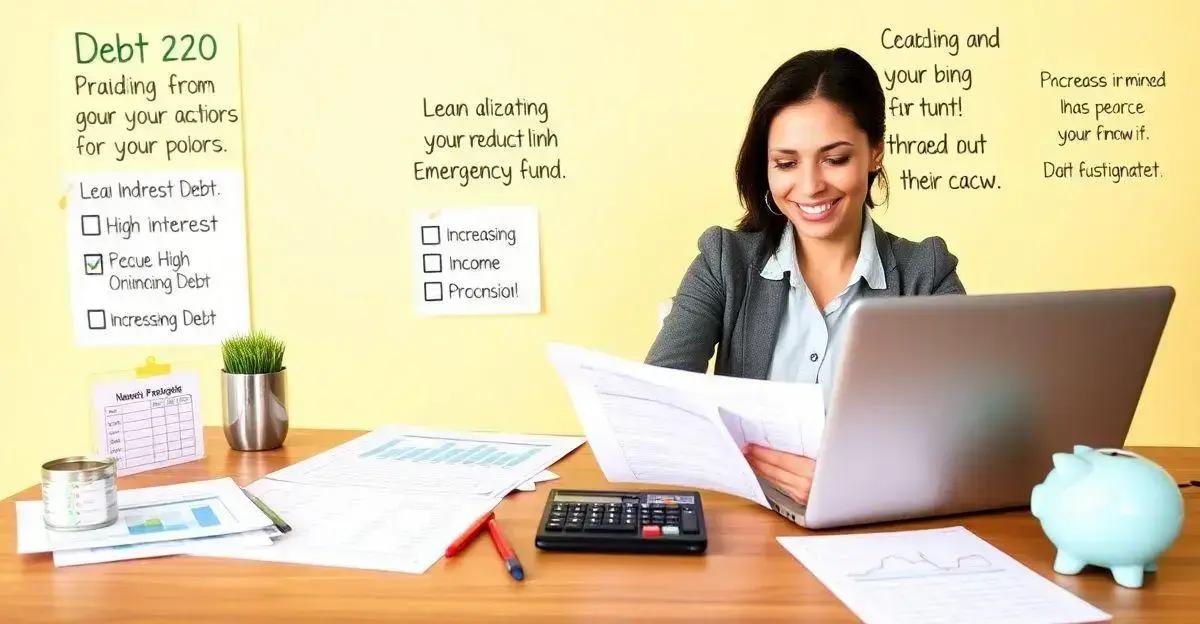Are you tired of living paycheck to paycheck, wondering how to manage debt as a single woman? You’re not alone. According to a recent study, 60% of single women struggle with debt. But there is hope.
With the right strategies and mindset, you can break free from financial stress and achieve financial freedom.
In this post, we’ll explore the secrets to managing debt as a single woman, from prioritizing your spending to creating a budget and paying off debt.
Whether you’re just starting out or already deep in debt, this guide will help you take control of your finances and start building a brighter financial future.
Prioritizing Your Debt
Prioritizing your debt is a crucial step in managing debt as a single woman. Start by making a list of all your debts, including the balance, interest rate, and minimum payment for each one. Then, sort your debts from highest interest rate to lowest. Focus on paying off the debt with the highest interest rate first, while making minimum payments on the others. This will save you the most money in interest over time. You can also consider consolidating your debt into a single loan with a lower interest rate or a balance transfer credit card.
A budget is a powerful tool for managing debt as a single woman. It helps you track your income and expenses, identify areas where you can cut back, and make informed financial decisions. Start by tracking your income and expenses for a month to get a clear picture of where your money is going. Then, categorize your expenses into needs (housing, food, utilities), wants (entertainment, hobbies), and debt repayment. Make sure to prioritize your debt repayment and allocate a portion of your income towards debt repayment. You can also use the 50/30/20 rule as a guideline to allocate your income: 50% for needs, 30% for wants, and 20% for debt repayment and savings.
Paying off high-interest debt is a key part of managing debt as a single woman. Start by making a list of all your high-interest debts, including the balance, interest rate, and minimum payment for each one. Then, focus on paying off the debt with the highest interest rate first, while making minimum payments on the others. You can also consider consolidating your debt into a single loan with a lower interest rate or a balance transfer credit card. Additionally, consider negotiating with your creditors to see if they can offer you a lower interest rate or payment plan.
An emergency fund is an essential part of managing debt as a single woman. It provides a cushion in case of unexpected expenses or financial setbacks, helping you avoid going further into debt. Aim to save three to six months’ worth of living expenses in an easily accessible savings account. You can also consider setting up automatic transfers from your checking account to your savings account to make saving easier and less prone to being neglected.
Increasing your income is a key part of managing debt as a single woman. Start by identifying areas where you can increase your income, such as taking on a side hustle, asking for a raise at work, or pursuing additional education or training. You can also consider selling items you no longer need or use to generate extra cash. Make sure to prioritize your debt repayment by allocating a portion of your increased income towards debt repayment.
Maintaining financial discipline is crucial to managing debt as a single woman. Start by tracking your income and expenses to ensure you’re staying on track with your budget. Make sure to prioritize your debt repayment and avoid falling back into bad spending habits. You can also consider working with a financial advisor or credit counselor to help you stay on track and achieve your financial goals.
Creating a Budget for Success

Creating a budget for success starts with tracking your income and expenses. Make a list of all your income sources and fixed expenses, such as rent and utilities. Then, categorize your expenses into needs, wants, and debt repayment. Be sure to prioritize your debt repayment and allocate a portion of your income towards it. You can also use the 50/30/20 rule as a guideline to allocate your income: 50% for needs, 30% for wants, and 20% for debt repayment and savings.
Paying off high-interest debt requires a strategic approach. Start by making a list of all your high-interest debts and prioritizing them based on their interest rates. Focus on paying off the debt with the highest interest rate first, while making minimum payments on the others. You can also consider consolidating your debt into a single loan with a lower interest rate or a balance transfer credit card. Additionally, negotiate with your creditors to see if they can offer you a lower interest rate or payment plan.
Building an emergency fund provides a safety net in case of unexpected expenses or financial setbacks. Aim to save three to six months’ worth of living expenses in an easily accessible savings account. You can also set up automatic transfers from your checking account to your savings account to make saving easier and less prone to being neglected. This fund will help you avoid going further into debt when unexpected expenses arise.
Increasing your income can provide a significant boost to your debt repayment efforts. Consider taking on a side hustle, asking for a raise at work, or pursuing additional education or training. You can also sell items you no longer need or use to generate extra cash. Make sure to prioritize your debt repayment by allocating a portion of your increased income towards it.
Maintaining financial discipline requires staying on track with your budget and debt repayment plan. Track your income and expenses to ensure you’re staying on track and avoid falling back into bad spending habits. You can also work with a financial advisor or credit counselor to help you stay on track and achieve your financial goals.
Prioritizing your debt is a crucial step in managing debt as a single woman. Start by making a list of all your debts and prioritizing them based on their interest rates. Focus on paying off the debt with the highest interest rate first, while making minimum payments on the others. This will save you the most money in interest over time.
Paying Off High-Interest Debt
Paying off high-interest debt requires a strategic approach. Start by making a list of all your high-interest debts and prioritizing them based on their interest rates.
Then, focus on paying off the debt with the highest interest rate first, while making minimum payments on the others.
You can also consider consolidating your debt into a single loan with a lower interest rate or a balance transfer credit card.
Additionally, negotiate with your creditors to see if they can offer you a lower interest rate or payment plan.
By paying off your high-interest debt, you can save money on interest and free up more money in your budget to tackle your other debts.
Building an Emergency Fund

Building an emergency fund provides a safety net in case of unexpected expenses or financial setbacks.
Aim to save three to six months’ worth of living expenses in an easily accessible savings account.
You can also set up automatic transfers from your checking account to your savings account to make saving easier and less prone to being neglected.
This fund will help you avoid going further into debt when unexpected expenses arise.
Additionally, having an emergency fund in place can also provide peace of mind and reduce financial stress.
By prioritizing saving and building an emergency fund, you can take control of your finances and achieve financial stability.
Increasing Your Income
Increasing your income can provide a significant boost to your debt repayment efforts.
Consider taking on a side hustle, asking for a raise at work, or pursuing additional education or training.
You can also sell items you no longer need or use to generate extra cash.
Make sure to prioritize your debt repayment by allocating a portion of your increased income towards it.
Additionally, consider negotiating with your employer to see if they can offer you a raise or additional benefits.
By increasing your income, you can take control of your finances and achieve financial stability.
Maintaining Financial Discipline

Maintaining financial discipline is crucial to achieving and maintaining financial stability. This includes sticking to your budget, avoiding impulse purchases, and making timely payments on your debts.
You can also set up automatic transfers from your checking account to your savings account to make saving easier and less prone to being neglected.
Additionally, consider working with a financial advisor or credit counselor to help you stay on track and achieve your financial goals.
By maintaining financial discipline, you can avoid falling back into bad spending habits and make progress towards achieving financial freedom.
Frequently Asked Questions about Artificial Intelligence in Small Business
What are the benefits of automating tasks for my small business?
Automating tasks frees up your team from repetitive activities, increasing productivity and allowing them to focus on more strategic tasks.
What tools can I use for data analysis?
There are various tools available, such as Google Analytics, Tableau, and Microsoft Power BI, that help collect and interpret valuable data.
What are chatbots and how do they improve customer service?
Chatbots are virtual assistants that can answer questions and solve problems at any time, improving the customer experience and freeing up your team.
How can I personalize the customer experience?
Through data analysis, you can better understand customer preferences and offer personalized recommendations and promotions.
Why is customer feedback important?
Feedback is essential for identifying areas that need improvement and adjusting your strategy to ensure customer satisfaction.
Is artificial intelligence accessible for small businesses?
Yes, there are various AI solutions that are accessible and scalable for small businesses to improve efficiency and customer service.
